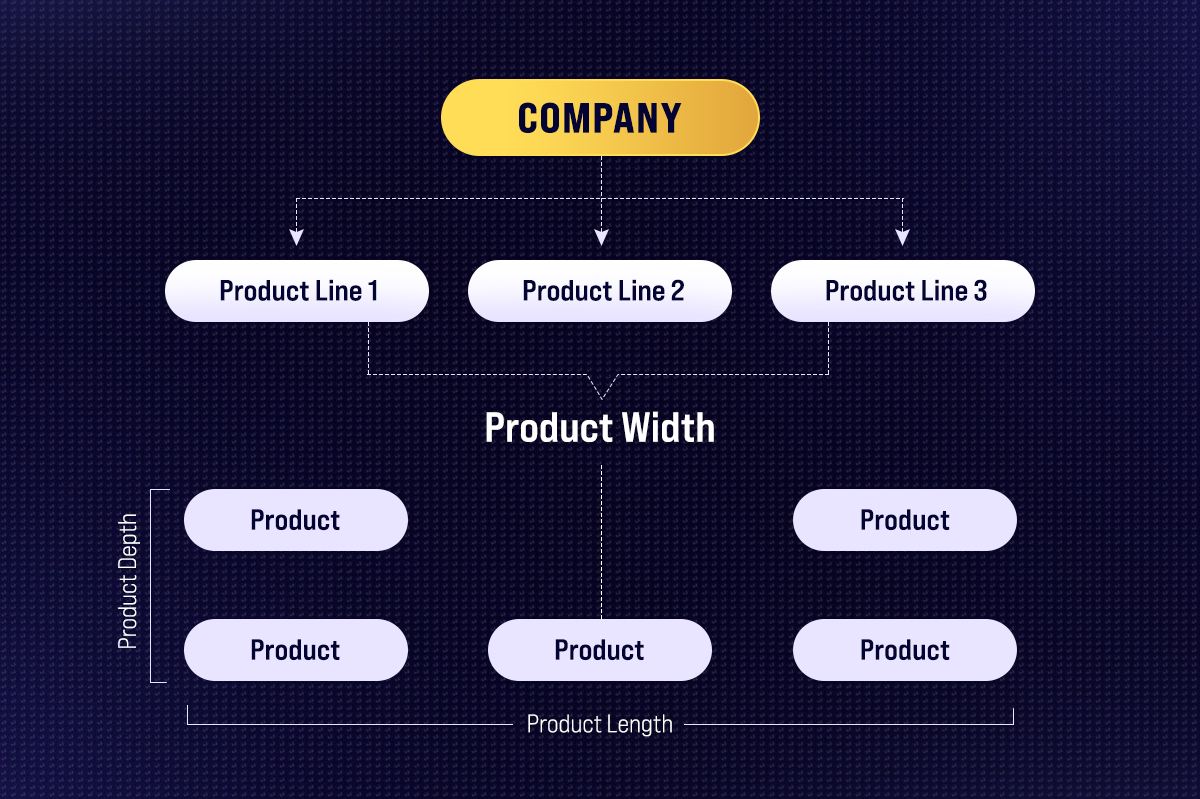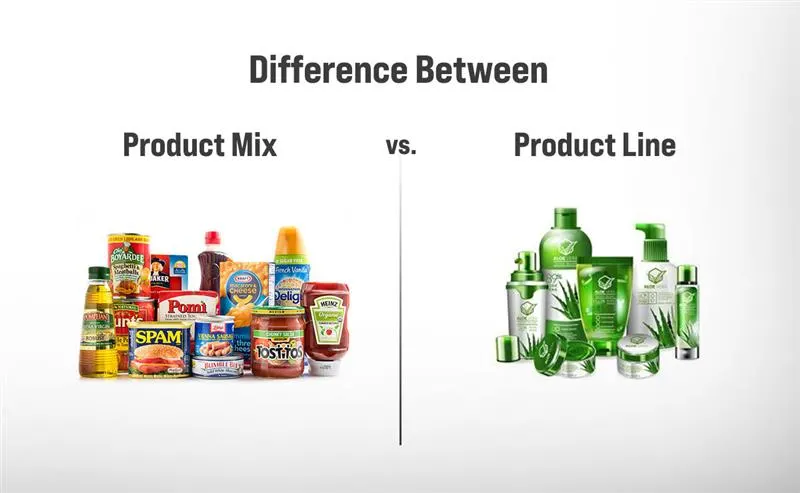Understanding Product Mix

In business, companies hardly sell a single product. They instead diversify their products to better meet customer needs, keep up with trends, and increase profitability. It is a deliberate strategy developed through thorough planning to please customers and expand the business.
For example, Apple offers a connected group of devices; Coca-Cola has many types of drinks, and Nike sells a wide range of shoes and clothing. Each of these companies shapes its product mix to stay ahead in the market.
So, what is a product mix, and why is it important? This article explains its main parts, why it matters, and how companies can review and improve their product mix to grow over time.
What is Product Mix?
A product mix is the complete set of products a brand sells, often across different categories. Some products are closely related, like different smartphone models, while others are very different, such as laptops or smartwatches.
A product mix is not just a collection of items; it reflects a company's brand, position, and customer strategy. Diversification of the product mix can help a business attract a wider range of customers, meet diverse consumer tastes and needs, and keep up with changing market trends, which in turn will lead to increased revenue and eventual growth.
Major Elements of a Product Mix

The four main parts of a product mix are width, length, depth, and consistency. Each one helps balance having a variety of products while keeping the brand’s identity clear.
1. Width of Product Mix
The width of a product mix means how many different product lines a company has. Having a wide product mix lets a business reach different types of customers and avoid relying on just one category.
For example, a software company offering CRM solutions, accounting software, and project management tools has a product mix width of three. While each line serves a separate business function, they collectively enhance the organization's market position.
An expansion of a product mix can be a strategic way to globalize the market or to respond to emerging consumer demands. Nevertheless, when handling multiple product lines, there needs to be investment in production, marketing, and customer support to ensure quality across the product line.
2. Length of Product Mix
The length of a product mix is the total number of different products a company sells across all its product lines. This shows how many products the company offers and how broad its selection is.
For instance, a home appliance manufacturer that sells:
- Refrigerators (5 models)
- Washing machines (4 models)
- Ovens (3 models)
Would have a total product mix length of 12 products.
Companies with longer product mixes can meet more customer preferences in each category. Still, managing many products means they need good inventory systems and ways to make each product stand out.
3. Depth of Product Mix
Depth is the number of choices that a single line of products has, in terms of size, color, taste, or technology. A deep product mix enables the companies to have more tailored solutions to the needs of individual customers.
For example, a smartphone brand might offer multiple variations of a single model, each with different storage capacities, screen sizes, or performance specifications. Similarly, a cosmetics brand could offer a foundation product in 20 different shades to cater to diverse skin tones.
A deeper product mix gives customers more choices, which can build loyalty and boost sales. However, it also means the company needs better inventory systems and a good understanding of what customers want.
4. Consistency of Product Mix
Consistency looks at how similar product lines are in terms of how they work, who they are for, how they are made, and how they are sold. High consistency makes operations smoother and keeps the brand clear, while low consistency lets a company offer more variety but takes more effort to manage.
For instance:
- A company that produces shampoo, conditioner, and body wash has a highly consistent product mix, as all products fall within the personal care industry.
- In contrast, a company selling smartphones, refrigerators, and skincare has low consistency, requiring different production and marketing strategies.
A very consistent product mix makes branding and running the business easier. But companies with many different product lines can protect themselves if one market changes, which lowers their overall risk.
What is a Product Item?
A product item is a single product in a company’s lineup, with its own features, price, and identity. For instance, Domino's classic hand-tossed pizza is one item from their menu. Similarly, an iPhone 15 Pro, a Nike Air Max sneaker, or a Starbucks Caramel Macchiato is an individual product item.
Product items can stand alone or be part of a product line made up of related products. For example, Domino’s has crunchy thin, Brooklyn-style, and gluten-free crusts as different options in its pizza line.
Having many product items helps businesses reach different customers. But if there are too many similar choices, new products might take sales away from older ones, which can hurt overall sales.
What is the Importance of Product Mixes?
A well-planned product mix is important to brands of any size. It helps businesses to diversify their services, increase their market presence, and maximize profitability. Strategic product portfolio management can help organizations to remain competitive and address the changing consumer trends. The following are some of the reasons why a product mix is necessary:
1. Addressing the Diverse Customer Needs
A broad product mix enables companies to serve diverse customer preferences across price points, features, and categories. For example, Apple offers a wide product mix, from budget-friendly iPhones to high-end MacBooks, catering to different user needs.
2. Capitalizing on Market Trends & Innovation
Companies with a flexible product mix can launch new products quickly when trends or new technologies appear. For example, car brands have started making electric vehicles to match what customers want and to support sustainability.
3. Improving Supply Chain Efficiency
A well-organized product mix helps companies run their supply chains more smoothly. Making or buying similar products together can lower costs, keep inventory in check, and make shipping easier. For example, a furniture company that makes sofas can also make matching chairs and tables using the same materials and methods.
4. Strengthening Brand Identity and Customer Loyalty
An aptly selected product blend helps individuals identify and believe in a brand. When customers like a particular product, they tend to sample other products of the same brand. For example, a person who likes Nike shoes will purchase Nike clothing, which creates loyalty.
5. Driving Cross-Selling and Upselling
A varied product mix lets businesses boost sales by suggesting add-ons or upgrades. For example, a computer store might recommend a case or software for a laptop, which can boost sales and make customers happier.
6. Maximizing Profitability
Not all products make the same amount of profit, but a balanced product mix can help cover less profitable items with those that earn more. This way, companies can take some risks and still keep their finances healthy.
Difference Between Product Mix vs. Product Line

While both the product line and the product mix are essential to a company’s product strategy, they serve distinct roles in product management. Here’s a breakdown of their key differences:
Categories | Product Line | Product Mix |
Definition | A product line refers to a group of closely related products under the same brand that cater to similar needs or functions. For example, Apple’s iPhone series is a product line. | A product mix encompasses the comprehensive array of all product categories a brand offers. For example, Apple’s entire range—including iPhones, MacBooks, iPads, and Apple Watches—forms its product mix. |
Scope and Focus | Focuses on depth, meaning it includes variations of a single type of product (e.g., different models, sizes, or features of a smartphone). | Emphasizes width, highlighting the quantity of product lines available across various segments. |
Strategic Impact | Expanding the product line (by adding new variations) strengthens a company’s presence within a specific market segment. | Expanding the product mix (by adding new product lines) helps a company enter new markets and target a broader audience. |
Factors Influencing Expansion | Product line growth is determined by factors such as price range, target audience, and product functionality. | Product mix growth is influenced by company age, financial stability, and brand identity—established companies tend to have a broader product mix. |
Cross-Selling Opportunities | Product line cross-selling encourages customers to buy different versions or accessories related to a product (e.g., an iPhone user buying AirPods). | Product mix cross-selling involves selling complementary products from different lines, increasing sales across various categories (e.g., Apple selling iPads, MacBooks, and iPhones together). |
Market Approach | Product line expansion helps strengthen a company’s dominance in a single market segment by offering more choices. | Product mix expansion allows businesses to diversify their portfolio, reducing dependency on a single product category. |
6 Key Product Mix Strategies
The most appropriate product mix strategy would be based on the business's desired goals, the market, and available resources. There are six key strategies employed by companies:
1. Expansion Strategy
Expansion strategy refers to the introduction of more products or product lines in an existing line. This can be used to attract new customers and satisfy various needs.
Types of Expansion:
- Product Line Extension: Adding variations to the existing product categories. (Example: Coca-Cola introducing Diet Coke and Coca-Cola Zero to health-conscious customers.)
- New Product Development: Venturing into new product lines. Further expansion of a product onto adjacent product lines and services (as in the case of Nike, moving from sports shoes to fitness gear and accessories).
Benefits:
- Targets new customer segments.
- Enhances brand recognition.
- Increases revenue potential.
2. Contraction Strategy
A contraction strategy means cutting back the product mix by stopping products that don’t sell well or are outdated. This helps companies focus on what works best and run more efficiently.
Types of Contraction:
- Product Line Pruning: It involves dropping products that are not selling fast in order to streamline resources. (Example: A manufacturer of a smartphone brand is ending older versions.)
- Divesting or Selling Products: Elimination of whole product lines that are no longer complementary to the business purposes.
Benefits:
- Cuts expenses and complexity of operation.
- Increases profitability through high-performance products.
- Saves resources to do more profitable investments.
3. Deepening Strategy
A deepening strategy introduces additional options within existing products to better suit what buyers are seeking. This helps businesses access smaller markets and better serve customers.
Example:
A makeup brand is launching additional foundation shades and formulas designed for various skin colors. Similarly, an automobile brand offers different fuel options (gasoline, electric, hybrid) within a single car model.
Benefits:
- Offers clients more personalized options.
- Strengthens brand loyalty by addressing specific customer requirements.
- Strengthens market penetration.
4. Diversification Strategy
Diversification strategy implies the launching of products in completely new and different categories. This contributes to the reduction of risks and identification of additional sources of income.
Examples:
- Amazon initially began as an online bookstore but has since expanded into electronics, cloud computing, and groceries (through the Whole Foods acquisition).
- Apple ceased hardware and entered the fields of music streaming, financial services (Apple Pay), and entertainment (Apple TV+).
Benefits:
- Diversify risks in business.
- Opens up new sources of revenue.
- Enhances market leadership.
5. Modernization Strategy
Modernization entails upgrading and improving existing products to ensure they remain relevant in the market. This may take the form of technological change, improvements in materials, or design advancements to accommodate the changing needs of the market.
Example:
- A CRM software company is integrating AI-powered automation to enhance its email marketing tools and stay up to date with the latest tech trends.
Benefits:
- Maintains products in dynamic markets.
- Gain customer satisfaction through added features.
- Helps uphold brand innovation.
6. Filling Strategy
Filling is the process by which a firm incorporates new products into an existing line to fill gaps and fulfill specific customer needs. This allows them to provide more products under the same category.
Example:
- A haircare brand that initially sells only shampoo and conditioner may introduce leave-in conditioners and hair masks to complete its product lineup.
Benefits:
- Strengthens customer loyalty by offering complementary products.
- Increases sales by catering to different needs.
- Helps businesses dominate a particular market segment.
How to Conduct a Product Mix Analysis

A product mix analysis is an important way for businesses to see how well their products are doing, how much money they make, and how they compare in the market. By looking at sales, customer needs, and competitors' offerings, companies can make better product decisions. Here’s how to do a full product mix review.
1. Organize Your Product Portfolio
Begin by listing all products and sorting them into their respective product lines and categories. Identify key attributes, including pricing, target audience, and unique selling points. Categorization provides clarity on how different products contribute to the overall portfolio and highlights any gaps in meeting customer needs.
2. Evaluate Financial Performance
Next, check how each product is performing financially by reviewing sales, revenue, and profit margins. This shows which products are most valuable and helps you decide on pricing, promotions, or which products to stop selling.
3. Track Key Performance Indicators (KPIs)
To fully understand how a product is doing, track key metrics such as how many units are sold, how many customers come back, and how often products are returned. These numbers show what’s working, what’s not, and where you can improve or adjust your product mix.
4. Gather and Analyze Customer Insights
Gather and review customer feedback, reviews, and survey results to understand how satisfied people are and what they want. Notice what features or prices customers prefer. This information helps you decide which products to improve, promote, or stop selling.
5. Identify and Address Product Cannibalization
Product cannibalization occurs when products in the same lineup compete with each other, hurting profits. Check to ensure your products work well together rather than compete. For example, you can make similar products for different customer types or uses.
6. Conduct a Competitive Analysis
Look at what your competitors sell to spot trends, gaps, and opportunities for improvement. Compare their product mix with yours to see how you match up in terms of variety, pricing, and new ideas. Use what you learn to make your products stand out or add new ones to meet customer needs.
7. Apply the 80/20 Rule (Pareto Principle)
The Pareto Principle states that 20% of your products account for 80% of your revenue. Find out which products are your top performers so you can focus on them and use your resources wisely. For the remaining 80%, decide whether to improve or remove them to keep your lineup efficient.
8. Regularly Review and Optimize
Product mix analysis should be done regularly, not just once. Keep checking your product mix to adjust to market changes, customer preferences, and competitors' moves. Use what you learn to keep your product mix up to date, profitable, and in line with your goals.
How Can You Examine a Competitor's Product Mix?
Understanding a competitor's product mix can provide strategic insights:
- Catalog Examination: Review competitors' product catalogs and websites to identify their product lines and items.
- Market Research: Review industry reports and consumer feedback to assess competitor product effectiveness.
- SWOT Analysis: Assess competitors' strengths, weaknesses, opportunities, and threats related to their product choices.
- Benchmarking: Measure your product offerings against competitors to recognize gaps and opportunities to stand out.
FAQs
Q1. What are the 4 components of the product mix?
Ans: The four essential elements of the product mix include:
- Width: The quantity of distinct product lines a company maintains.
- Length: The overall number of products across all product lines.
- Depth: The number of variations (e.g., sizes, colors, flavors) within a single product line.
- Consistency: The level of resemblance between product lines regarding application, manufacturing, and distribution.
Q2. What are the 7Ps of product mix?
Ans: The 7Ps of the product mix encompass:
- Product: This refers to the goods or services offered to the consumers.
- Price: The amount that consumers pay for the product.
- Place: The distribution channels and locations where one markets the product.
- Promotion: This is a marketing strategy to raise product awareness.
- Personnel: Customer care and support staff who shape the customer experiences.
- Process: The activities and structures of selling the product or service.
- Physical Evidence: Physical elements that enhance brand recognition, such as containers or retail space, or digital presence.
Summing Up
A well-planned product mix helps businesses grow by meeting different customer needs, staying competitive, and making more profit. By managing width, length, depth, and consistency, companies can improve their products and keep up with market changes.
Checking your product mix regularly helps you find ways to grow, update, or simplify your products, which supports long-term success. By diversifying, innovating, or planning carefully, a strong product mix builds your brand, keeps customers loyal, and helps your business succeed as the market changes.





